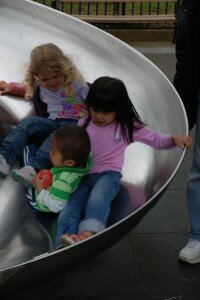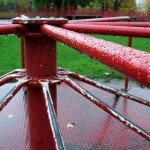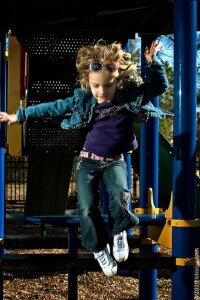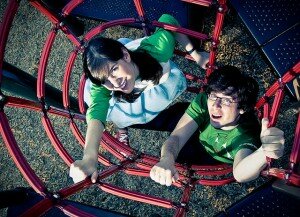Archives
| M | T | W | T | F | S | S |
|---|---|---|---|---|---|---|
| « Mar | Oct » | |||||
| 1 | 2 | 3 | 4 | 5 | 6 | 7 |
| 8 | 9 | 10 | 11 | 12 | 13 | 14 |
| 15 | 16 | 17 | 18 | 19 | 20 | 21 |
| 22 | 23 | 24 | 25 | 26 | 27 | 28 |
| 29 | 30 | 31 | ||||
Playgrounds and Social Media
I’ve been thinking about the similarities between playgrounds and social media lately. As the school year is launching, I am thinking of ways that we can continue to enlighten our communities about the need to help students navigate the world of social media in a safe environment, part of helping them along the road to becoming good digital citizens. For some reason, my thinking keeps coming back to playgrounds.
Children love the freedom of playgrounds. They can explore, challenge themselves, and make new friends. From an early age, parents take their children to playgrounds to run and play, teaching them how the various equipment works, and give them safety tips, always keeping a watchful eye to make sure they don’t get too rambunctious lest they forget about the safe way to climb, swing, and spin. We encourage them to make friends, and play nicely. Yes, there are inherent risks, but parents, and indeed school staff and volunteers on school playgrounds are there to remind the children if they are straying too far into an “unsafe” zone or using inappropriate behavior. As children get older, we relax a little bit, trusting that children have learned the rules of the playground, and will self-monitor. On very large playgrounds, where large numbers of children play, such as a school playground, we recognize that it is impossible to monitor every child at every moment. Children interact with each other and explore all that the playground has to offer. They test themselves both physically and socially. This is a learning process.
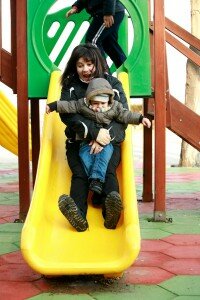
Posted Under Creative Commons. Photo by Tasslehoff Burfoot.
We recognize risk exists here, yet we do not close down the playgrounds, or block children from accessing them. Adults are very much involved in the process of teaching children to play safely, and we monitor them along the way. We recognize this as a part of growing up, and indeed we do, little by little, turn over responsibility for safe and appropriate behavior in such a setting to the children. If a child oversteps the boundaries that are set for safety, if bullying takes place, or any other inappropriate social behavior, there are consequences. But the goal is to ultimately teach them how to be safe and appropriate so they can self-monitor and enjoy all that the playground has to offer in the future. If a child misbehaves on the playground, we do not take away access to the playground for the whole community or school. That doesn’t make sense. We deal with the individual child who acted inappropriately.
Social media is a kind of playground – but one that is much less familiar to most adults. As my colleague Linda Conway has observed, kids started participating in social media far before adults went there, and they made their own rules. No one taught them appropriate and safe behavior along the way, and no one monitored them in this environment. I use the past tense here, because I think that we are beginning to see a shift in this now, but we still have a lot of catching up to do. Social media has so much to offer our students in terms of making global connections and learning from people that they never would have had the opportunity to interact with prior to this technology. But our children are largely still unaware of what appropriate behavior looks like in this environment, especially if they use the model of the children who played without rules before them. Just like on a playground, we need to show them how to be safe and appropriate – and much of this might be by modeling it ourselves. We have a responsibility to do this for them, so we need to be there with them, and show them how to use social media to effectively communicate and learn. We need to use it in our schools, as well as at home. School districts should explore how they can provide the necessary guidance and training for students in the appropriate use of social media within a safe environment. Like it or not, social media is here to stay, and kids want to be a part of it. They will find a way. So let’s explore it together, in a safe environment, and set some boundaries. Let’s use it to help them learn.
The First Day
 Tomorrow a new school year begins. Students and teachers alike are full of anticipation, excitement, and hope. The schools have been thoroughly cleaned, supplies have been re-stocked, textbooks are ready to be distributed, and computers powered up and made ready. The library media center is neatly organized and ready for students in search of good stories and information. Teachers and staff have been busy planning for The First Day. Bulletin Boards have been put up, class lists are printed out, and lesson plans drafted. The business of learning is about to begin in full force.
Tomorrow a new school year begins. Students and teachers alike are full of anticipation, excitement, and hope. The schools have been thoroughly cleaned, supplies have been re-stocked, textbooks are ready to be distributed, and computers powered up and made ready. The library media center is neatly organized and ready for students in search of good stories and information. Teachers and staff have been busy planning for The First Day. Bulletin Boards have been put up, class lists are printed out, and lesson plans drafted. The business of learning is about to begin in full force.
At some point during the day, all of us – students, teachers, parents, and administrators should step back and take a good look around. How can you capture the spirit and hope of this very special day?
I wonder what it is, in particular, that makes this day so special? Is it the new supplies? The excitement of finding out who is in your class? Is it the anticipation of learning new things? The First Day is your chance to set the stage for the coming year. What kind of place will your classroom be?
I wish all of you a beautiful First Day – full of wonder!

